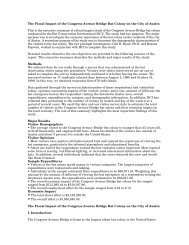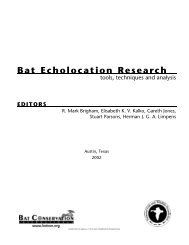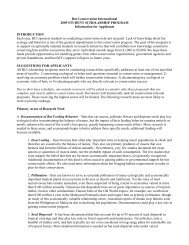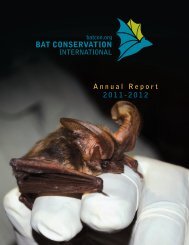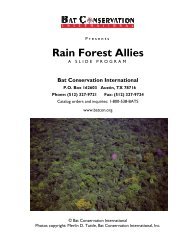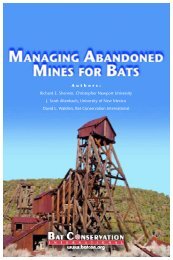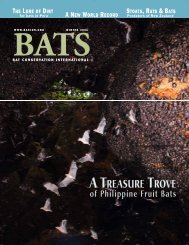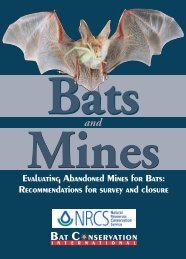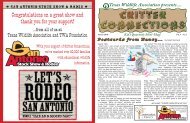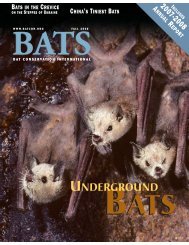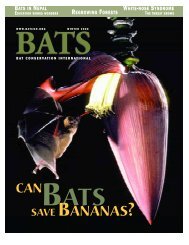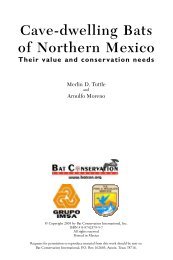Bat Conservation and Management Workshop
Bat Conservation and Management Workshop
Bat Conservation and Management Workshop
You also want an ePaper? Increase the reach of your titles
YUMPU automatically turns print PDFs into web optimized ePapers that Google loves.
BCI <strong>Bat</strong> <strong>Conservation</strong> <strong>and</strong> <strong>Management</strong> <strong>Workshop</strong> – Arizona<br />
(Ceuthophilus conicaudus <strong>and</strong> Hadenoecus<br />
subterraneus) are believed to use air currents in their<br />
orientation to <strong>and</strong> from cave entrances (Reichle et al.,<br />
1965; Campbell. 1976; Levy, 1976). Additionally, air<br />
flow <strong>and</strong> associated patterns of temperature <strong>and</strong><br />
humidity are as predictable in many caves as are many<br />
other cues that are used by surface animals. Many<br />
cavernicolous animals are thought to be extremely<br />
sensitive to even slight changes in air flow,<br />
temperature, <strong>and</strong> humidity (Barr, 1959, 1961, 1964,<br />
1967; V<strong>and</strong>el, 1965), <strong>and</strong> the role of air flow as a<br />
seasonal or daily cue may be of major importance in<br />
some caves.<br />
Beyond the cue effects of air movement <strong>and</strong><br />
temperature, temperature directly affects a variety of<br />
trogloxenes (animals that live in caves but cannot<br />
complete their life cycles without leaving caves). <strong>Bat</strong>s<br />
will be discussed in detail later. Our casual<br />
observations indicate that cold caves which harbor<br />
hibernating bats often additionally serve as<br />
hibernating sites for a variety of otherwise surface<br />
arthropods (e.g. culicine mosquitoes <strong>and</strong> the noctuid<br />
moth Scoliopteryx libatrix) that were not often found<br />
in warmer caves. On the other h<strong>and</strong>, these same cold<br />
caves rarely contained amphibians, such as Eurycea<br />
lucifuga <strong>and</strong> Plethodon glutinosus (even when relative<br />
humidity remained high), which often were abundant<br />
in other caves nearby. Even if the major effects of air<br />
movement <strong>and</strong> temperature were limited to<br />
determining the within <strong>and</strong> among cave distributions<br />
of such trogloxenes as bats <strong>and</strong> cave crickets, they<br />
ultimately could exert strong indirect effects on<br />
troglobitic (animals that are so highly specialized that<br />
they cannot live outside of caves) <strong>and</strong> troglophilic<br />
(animal that often live their entire lives underground<br />
but also can live in moist places under rocks or logs<br />
on the surface) cave animals that depend on these<br />
animals as primary sources of energy.<br />
Dependable food sources in a cave environment are of<br />
vital consequence to its fauna; whether they be guano<br />
from bats <strong>and</strong> crickets, entrance litter, or detritus from<br />
floods, supplies vary seasonally (Barr, 1967). Strong<br />
selective pressure must exist for the development of<br />
responses to such available cues as changes in water<br />
temperature, pH <strong>and</strong> oxygenation (for aquatic<br />
animals), air flow, temperature <strong>and</strong> humidity (for<br />
terrestrial animals), <strong>and</strong> flooding. In fact, initial<br />
studies indicate that many troglobites, both terrestrial<br />
<strong>and</strong> aquatic, use seasonal flooding to time peaks of<br />
reproduction (see Barr, 1968; Poulson <strong>and</strong> Smith,<br />
1969; Juberthie, 1975, among others).<br />
Clearly, the potential impact of the above environmental<br />
factors in determining species survival <strong>and</strong> distribution is<br />
great <strong>and</strong> the problems complex. We make no pretense of<br />
underst<strong>and</strong>ing more than the potential importance of these<br />
variables. It is important, however, to note the extent to<br />
which the environment of the cave depends on its<br />
exchange of air <strong>and</strong> water with the outside. Hopefully, our<br />
discussion of cave structure <strong>and</strong> the causes <strong>and</strong><br />
predictability of daily <strong>and</strong> seasonal patterns of air flow,<br />
temperature, <strong>and</strong> humidity will act as a stimulus for much<br />
further investigation of these potentially important<br />
environmental parameters.<br />
Temperature Constraints on Cave <strong>Bat</strong>s<br />
For most bats, <strong>and</strong> especially for cave dwelling species,<br />
the selection of appropriate roosting temperatures is of<br />
critical importance (Harmata, 1973). Twente (1955) noted<br />
that it was vital for bats to choose roosts with temperatures<br />
appropriate to the desired metabolic processes: warm for<br />
digestion <strong>and</strong> growth in the summer, <strong>and</strong> cool for torpor in<br />
the fall <strong>and</strong> winter, with the exact optimum temperatures<br />
varying somewhat among species. McManus (1974) found<br />
that hibernating Myotis lucifugus in a New Jersey mine<br />
"demonstrated a clear preference for temperatures near<br />
2°C the temperature at which Hock (1951) found the<br />
species' oxygen consumption to be lowest. Harmata<br />
(1969) demonstrated that Rhinolophus hipposideros could<br />
select "the proper temperature of hibernation" with<br />
accuracy as near as 0.8°C.<br />
Whatever the mechanism of selection, microspatial<br />
distribution preferences <strong>and</strong> movements along temperature<br />
gradients also have been demonstrated in summer roosts<br />
of many species, with clustering playing a role in<br />
behavioral temperature regulation then as well as in winter<br />
(Licht <strong>and</strong> Leitner, 1967; Harmata, 1969, 1973; Tuttle,<br />
1975; Trune <strong>and</strong> Slobodchikoff, 1976, among others). A<br />
number of authors have noted the high metabolic cost of<br />
the wrong ambient temperature for bats (Hock, 1951;<br />
Herreid, 1963; Stones, 1965; Davis, 1970; McManus,<br />
1974).<br />
For cave dwelling species, caves with roosts of<br />
appropriate temperatures are limited in number. At<br />
extremely high latitudes caves may be too cold for use at<br />
any time. At somewhat lower latitudes, where MAST<br />
ranges 2 to 12°C, caves often provide appropriate<br />
hibernating quarters but are normally too cold to permit<br />
summer use. In areas of intermediate latitudes (MAST 12<br />
to 20°C most caves are too warm in winter <strong>and</strong> too cold in<br />
© 2011 – <strong>Bat</strong> <strong>Conservation</strong> International Page 31



